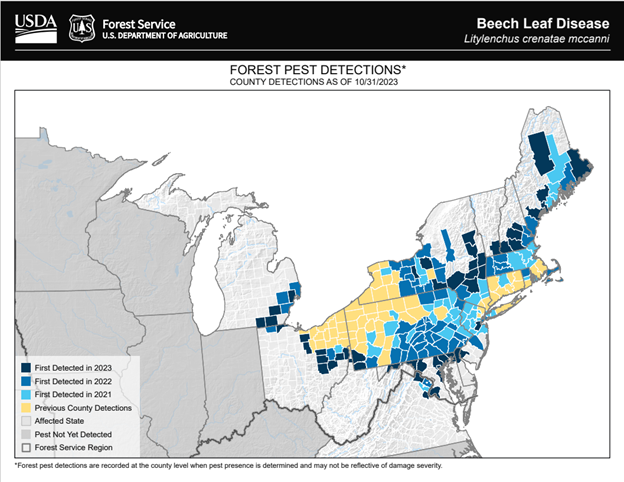Last updated: March 13, 2025
Article
Beech Leaf Disease in Acadia

NPS Photo/Jesse Wheeler.
Visitors to Acadia’s hardwood forests this year may notice a significant change in the understory foliage and even the canopy above. Dark green bands between leaf veins or curled, browning leaves are the distinctive signs of beech leaf disease, a new threat to American beech trees (Fagus grandifolia) in Acadia National Park and beyond.
This emerging disease is associated with a parasitic nematode (Litylenchus crenatae mccannii), one of several pathogens and pests impacting beech trees across eastern North America. This species feeds on leaf buds of many beech species, including the native American beech as well as European beech (Fagus sylvatica) and other cultivars. Damage to leaf buds in early spring produces banded, crinkled, or leathery leaves, but severe infestations can also kill buds before leaf-out. The early loss of damaged leaves and thinning of the canopy over several years leads to decline and mortality, especially in younger trees. It also leaves stressed beech trees more vulnerable to other threats, including beech bark disease.
First reported in the United States in 2012, beech leaf disease has only recently spread to Maine (2021) and the town of Mount Desert (2022) within Acadia National Park. It is now known to be widespread throughout the park. American beech is an abundant canopy tree species, visible along the trails and carriage roads surrounding Jordan Pond and Eagle Lake and on the shores of Echo Lake and Long Pond. Beech is known for its golden yellow fall foliage and, as a broad-leaved tree that is more tolerant of shade than many others, beech occupies a unique place in the canopy of mature forests. Beech trees are essential larval hosts for many insects and beech nuts are among the most nutrient-dense food sources available to mammals and birds. Though widespread beech bark disease has decreased its forestry value, American beech remains an important component of forests across the eastern United States and Canada. The combined impact of these multiple threats is already becoming visible in Acadia.
In response, Acadia’s natural resource managers are working with the US Forest Service, which manages a regional monitoring network for beech leaf disease. The monitoring plot in Acadia, which was installed before beech leaf disease was documented in the park, is one of many monitoring locations across the current and potential extent of beech leaf disease. Studies like this will help us understand its large-scale impacts, movement over time, and associations with other pests and pathogens. There is still much to learn about this forest health issue, including how to effectively manage affected trees and forests.
While there is currently no treatment strategy developed to manage beech leaf disease on the scale of Acadia’s forested landscape, landowners may have success treating trees individually. Applying high-potassium fertilizers has improved the health of affected trees in preliminary trials (see Treatment of Beech Trees with Beech Leaf Disease in Maine on the Maine Forest Service information page). Though its distrubution across the park is well-known by natural resource managers, visitors can learn to identify beech leaf disease symptoms and report it in areas where it is not yet documented.

USFS.
